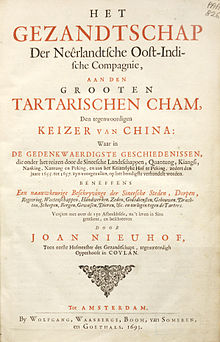User:PaulVanO/sandbox/AnEmbassy
 | |
| Author | Johan Nieuhof |
|---|---|
| Original title | Het gezantschap der Neêrlandtsche Oost-Indische Compagnie aan den grooten Tartarischen Cham, den tegenwoordigen keizer van China |
| Translator | John Ogilby |
| Illustrator | Johan Nieuhof |
| Country | Netherlands |
| Language | English |
| Subject | China |
| Genre | Travel literature |
| Published | 1669 |
An embassy from the East-India Company of the United Provinces, to the Grand Tartar Cham, emperor of China is a book written by Dutch author and explorer Johan Nieuhof. The full title of English version of the book is An embassy from the East-India Company of the United Provinces, to the Grand Tartar Cham, emperor of China: delivered by their excellencies Peter de Goyer and Jacob de Keyzer, at his imperial city of Peking wherein the cities, towns, villages, ports, rivers, &c. in their passages from Canton to Peking are ingeniously described by John Nieuhoff; Englished and set forth with their several sculptures by John Ogilby[1]. The book served as a major influence in the rise of chinoiserie in the early eighteenth century.
Publication history[edit]
The book was first published in Dutch in 1665 by Johan's brother Hendrik and the Amsterdam based publisher and printer Jacob van Meurs. It's original title was Het Gezandtschap der Neêrlandtsche Oost-Indische Compagnie, aan den grooten Tartarischen Cham, den tegenwoordigen Keizer van China: Waarin de gedenkwaerdigste Geschiedenissen, die onder het reizen door de Sineesche landtschappen, Quantung, Kiangsi, Nanking, Xantung en Peking, en aan het Keizerlijke Hof te Peking, sedert den jaren 1655 tot 1657 zijn voorgevallen, op het bondigste verhandelt worden. Beneffens een Naukeurige Beschrijvinge der Sineesche Steden, Dorpen, Regeering, Weetenschappen, Hantwerken, Zeden, Godsdiensten, Gebouwen, Drachten, Schepen, Bergen, Gewassen, Dieren, et cetera en oorlogen tegen de Tartar : verçiert men over de 150 afbeeltsels, na't leven in Sina getekent.[2].
Because of the immense success it enjoyed, several other editions, albeit heavily edited and geared towards commercial interests, soon appeared. It was also translated into French, German, Latin and eventually into English in respectively, 1665, 1666, 1168 and 1669. The English version was not published by Van Meurs, but by John Ogilby instead.
Description of content[edit]
The book consists of the notes and illustrations that Nieuhof made in his position as a steward on Peter de Goyer and Jacob de Keizer's embassy to the emperor of China. These notes and illustrations were left in the care of his brother Hendrik, "so as they not fall prey to rugged seas and hollow waves". This manuscript was eventually bundled and published to form this book, containing a written account of the embassy as well as 149 illustrations.

The work itself is split into two parts. The first part contains the written account of the embassy led by Peter de Goyer and Jacob de Keizer to the emperor of China. It details the entire journey from Canton to Peking and back again. This part also contains descriptions and depictions of all that the embassy came to pass on it its trip. The second part consists of a general overview of China, wherein a variety of subjects comes to pass, containing descriptions and images of bridges, mountains, temples, customs, et cetera.
References[edit]
- ^ Nieuhof, Johan. "An embassy from the East-India Company of the United Provinces, to the Grand Tartar Cham, emperor of China; Englished and set forth with their several sculptures by John Ogilby". Jacob van Meurs. Retrieved 7 Mei 2014.
{{cite web}}: Check date values in:|accessdate=(help) - ^ Nieuhof, Johan (1665). "Het gezantschap der Neêrlandtsche Oost-Indische Compagnie, aan den grooten Tartarischen Cham, den tegenwoordigen keizer van China : waar in de gedenkwaerdighste geschiedenissen, die onder het reizen door de Sineesche landtschappen, Quantung, Kiangsi, Nanking, Xantung en Peking, en aan het keizerlijke hof te Peking, sedert den jare 1655 tot 1657 zijn voorgevallen, op het bondigste verhandelt worden : befeffens een naukeurige Beschryving der Sineesche steden, dorpen, regeering, wetenschappen, hantwerken, zeden, godsdiensten, gebouwen, drachten, schepen, bergen, gewassen, dieren, &c. en oorlogen tegen de Tarters : verçiert men over de 150 afbeeltsels, na't leven in Sina getekent". Jacob van Meurs. Retrieved 7 Mei 2014.
{{cite web}}: Check date values in:|accessdate=(help)CS1 maint: numeric names: authors list (link)
